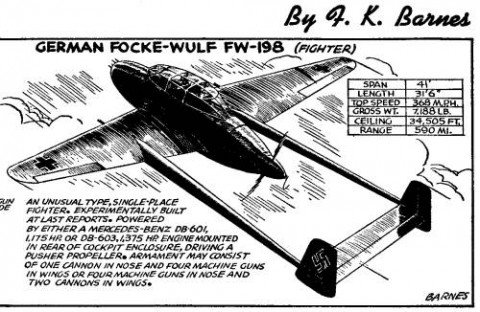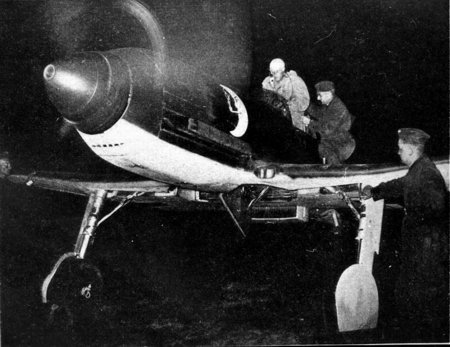An alternative Battle of Britain -- II

Fw 198. Image source: Current Aviation, 26 November 1943, via Model Airplane Kits.
In the course of my research, I get to read many predictions about the future, partiularly the future of warfare. One of the reasons I like doing this is that it helps to restore the uncertainty of what used to be the future, but is now the past. I know (more or less!) the events which lay in the future of the writers whose dusty old books I read. They did not. This is completely obvious, of course, but it can be hard to remember this, and to put myself into the mindset of someone who lacked my knowledge of what was going to happen next. In reading their predictions of future events, I can get back some sense of their open future, which my past has closed off to me.
An example of this is the Battle of Britain: the many representations of the aerial combat between the Luftwaffe and the RAF in the last 66 years have fixed the combatants in our memory. From movies, documentaries, books, games, and even alcoholic beverages, we all1 know of the defending fighters, the valiant Spitfire and trusty Hurricane; and their opponents, the dangerous Me 109 fighter and the not-so-dangerous Me 110. We know that the Spitfire and Me 109 were the best fighters on their respective sides, and indeed were pretty evenly matched; that the Me 110 was outclassed by the Spitfire and Hurricane; that in turn the lesser British fighters (the Defiant, the Blenheim and the Gladiator) were soon placed out of harm's way; and so on.
But these sorts of facts weren't obvious at the time, not even to a well-informed observer like J. M. Spaight, recently retired from a top civil service post in the Air Ministry, and author of The Sky's the Limit. I've already looked at his praise of the Defiant, and his misplaced confidence that it would be one of the star performers in the Battle of Britain then raging overhead. His views on the German fighter aircraft are equally surprising. For example, he makes the startling statement that 'The Me 110 is undoubtedly a more formidable machine than the Me 109'.2 This is not a misprint, for he goes on to list the inferior characteristics of the Me 109: low manoeuvrability, wing and aileron flutter problems, a high stalling speed, unsuitability for night operations, poor streamlining, a badly-designed undercarriage, and a tendency to stall on high-speed turns. Despite all these supposed flaws, during the Battle Me 109s were in fact called upon to escort Me 110s on occasion! But Spaight had good reasons to be wrong about the Me 109: he drew upon the reports of French pilots who had flown a captured model, and the opinion of Sydney Camm, legendary designer of the Hurricane, among other Hawker aircraft.
Spaight also believed that the Luftwaffe was operating a much wider variety of aircraft than was actually the case. For example, he reported that besides Me 109s and Me 110s, the opposing fighter force included He 112s and He 113s, along with Fw 187s and (in the near future) Fw 198s. None of this was true. The He 112 was one of the competitors beaten out for a Luftwaffe contract by the Me 109; a dozen intended for the Imperial Japanese Navy were temporarily pressed into service during the Czech crisis in 1938. The Fw 187 was a twin-engine fighter like the Me 110, and in fact much superior to it; but it was only tested by the Luftwaffe in late 1940, well after Spaight's book was published. And the He 113 and Fw 198 never existed at all! The former was thought to be very fast, with a top speed of 400 mph; while the latter was supposedly (and unusually) a pusher aircraft, `with a ring of machine-guns in the nose, and this is said to enable a cone of fire to be directed at the target with more destructive effect than when the guns are located in the wings'.3 Spaight wasn't to know that the He 113 existed only in German propaganda, and the Fw 198 only in British imagination.
In reality, it would not necessarily have been to Germany's advantage to field five or six different fighter types, instead of the two it actually did. As Richard Overy explained in Why the Allies Won: Explaining Victory in World War II (London: Pimlico, 1996), concentrating on a few good types allows economies of scale and standardisation of parts. (Indeed, a proliferation of vehicle types bedevilled the German armed forces later in the war.) But I wonder if Spaight's readers might not have taken away from his array of Messerschmitts, Heinkels and Focke-Wulfs the message that Germany's aerial legions were, well, legion. Of course, they would also have been reassured by his assertions that none of the new German aircraft were `as formidable a fighter as some new types which we have not brought out of the bag as yet'.4
So, in summary, here is Spaight's predicted starting line-up for the German fighter force, in addition to the familiar Me 109 and Me 110 -- kind of a fantasy Jägergeschwader for a battle which never happened:
He 112. Image source: Flug Revue.
He 113. Image source: Wikipedia.
Fw 187. Image source: Wikipedia.
Fw 198. Image source: The Aeroplane, 15 February 1940, via Model Airplane Kits.
In the final part, I'll look at Spaight's thoughts on the German bombers and on the future.